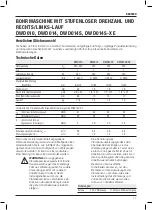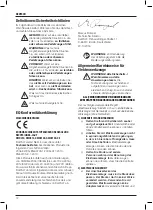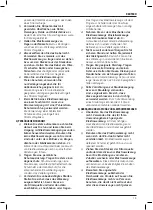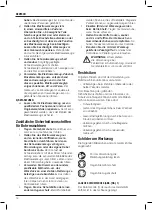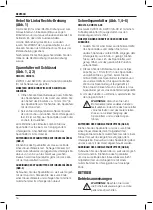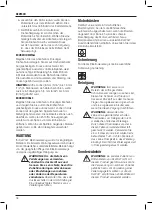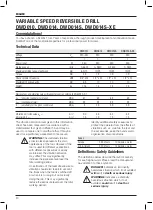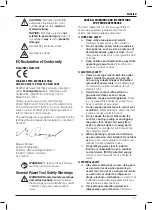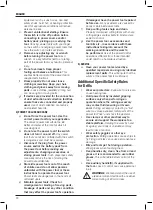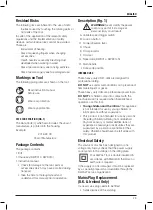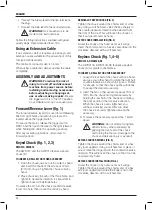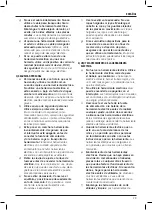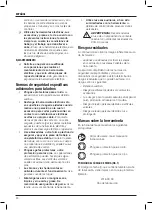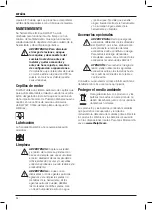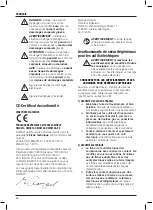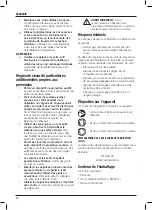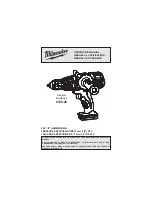
25
english
Drilling
WARNING:
To reduce the risk of
personal injury,
ALWAYS ensure
workpiece is anchored or clamped
firmly. If drilling thin material, use a wood
“back-up” block to prevent damage to
the material.
1. Use sharp drill bits only. For WOOD, use the
low speed setting and twist drill bits, spade bits,
power auger bits, or hole saws. For METAL, use
the low speed setting and steel twist drill bits or
hole saws.
2. Always apply pressure in a straight line with the
bit. Use enough pressure to keep drill biting, but
do not push hard enough to stall the motor or
deflect the bit.
3. Hold tool firmly with both hands to control the
twisting action of the drill.
CAUTION:
Drill may stall if overloaded
causing a sudden twist. Always expect
the stall. Grip the drill firmly to control
the twisting action and avoid injury.
4.
IF DRILL STALLS
, it is usually because
it is being overloaded or improperly used.
RELEASE TRIGGER IMMEDIATELY
, remove
drill bit from work, and determine cause of
stalling.
DO NOT CLICK TRIGGER ON
AND OFF IN AN ATTEMPT TO START A
STALLED DRILL — THIS CAN DAMAGE
THE DRILL
.
5. To minimize stalling or breaking through the
material, reduce pressure on drill and ease the
bit through the last fractional part of the hole.
6. Keep the motor running when pulling the bit
back out of a drilled hole. This will help prevent
jamming.
7. With variable speed drills there is no need to
center punch the point to be drilled. Use a
slow speed to start the hole and accelerate by
squeezing the trigger harder when the hole is
deep enough to drill without the bit skipping
out.
DRILLING IN METAL
Start drilling with slow speed and increase to full
power while applying firm pressure on the tool.
A smooth even flow of metal chips indicates the
proper drilling rate. Use a cutting lubricant when
drilling metals. The exceptions are cast iron and
brass which should be drilled dry.
NOTE:
Large [5/16" (8 mm) to 1/2" (13 mm)] holes
in steel can be made easier if a pilot hole [5/32"
(4 mm) to 3/16" (5 mm)] is drilled first.
OPERATION
Instructions for Use
WARNING:
Always observe the safety
instructions and applicable regulations.
WARNING: To reduce the risk of
injury, turn unit off and disconnect
machine from power source
before
installing and removing accessories,
before adjusting or changing set-
ups or when making repairs.
Be sure
the trigger switch is in the OFF position.
An accidental start-up can cause injury.
Trigger Switch (fig. 1)
To start the drill, depress the trigger switch; to stop
the drill, release the trigger switch.
NOTE:
Use lower speeds for starting holes without
a center punch, drilling in metal or plastics, driving
screws or drilling ceramics. Higher speeds are better
for drilling wood and composition boards and using
abrasive and polishing accessories.
VARIABLE SPEED
A variable speed trigger switch (A) permits speed
control—the farther the trigger is depressed, the
higher the speed of the drill.
For continuous operation, press and hold the
variable speed switch, move the lock-on button (B)
up, then release the switch.
To stop continuous operation, press the switch
briefly and release it. Always switch the tool off when
work is finished and before unplugging.
Speed Dial (fig. 1)
DWD014, DWD014S
To reduce the speed, turn the speed dial (G)
counterclockwise. To increase speed, turn the dial
clockwise.
Proper Hand Position (fig. 7)
WARNING:
To reduce the risk of
serious personal injury,
ALWAYS
use proper hand position as shown
in figure 7.
WARNING:
To reduce the risk of
serious personal injury,
ALWAYS
hold
securely in anticipation of a sudden
reaction.
Proper hand position requires one hand under the
the housing, with the other hand on the main handle
(H).
Содержание DWD010
Страница 1: ...DWD010 DWD014 DWD014S Final Page size A5 148mm x 210mm ...
Страница 4: ...2 Figure 2 Figure 3 Figure 5 Figure 6 Figure 4 D ...
Страница 5: ...3 Figure 7 H ...

